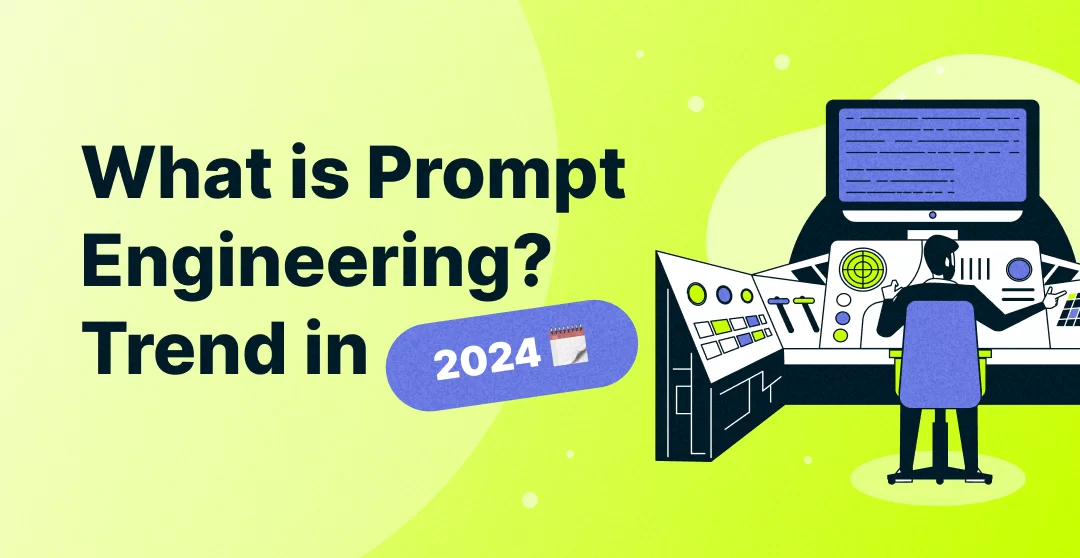What is Prompt Engineering? Trend in 2024
 Christopher Garzon
Christopher Garzon
What is Prompt Engineering?
Prompt engineering, at its essence, is an approach designed to effectively communicate with sophisticated computational models, particularly those driven by machine learning and natural language processing technologies. This emerging field is integral to the development and optimization of algorithms that interpret and respond to human inputs in a meaningful way. By meticulously crafting prompts or input queries, engineers can steer these models to produce specific, desired outcomes, ranging from generating text to synthesizing information or even creating intricate data patterns.
The science of prompt engineering lies in the ability to understand and manipulate the language model’s responses through strategic input design. This not only involves a deep comprehension of the model’s mechanics but also requires an insightful consideration of the context and objectives behind each interaction. As such, prompt engineering stands at the intersection of technology and linguistics, employing both to achieve greater precision and relevance in machine-generated responses.
As we look towards 2024, with the exponential growth of artificial intelligence applications in various domains, prompt engineering has become a critical skill set. It enables the creation of more natural, efficient, and user-centric interactions between humans and AI systems. From automating customer service inquiries to generating content and even aiding in complex decision-making processes, the applications of prompt engineering are vast and varied.
The Evolution of Prompt Engineering
AI interaction was practically mechanical in its very early stages and pretty linear, involving basic command and response structures. This meant the actual very first instances of AI interaction required the user to be incredibly direct and specific if they were to get the desired outcomes, exactly mirroring the extremely poor level of understanding of and capabilities within the field.
As research and development in AI began to boom, the complexity and sophistication of AI models increased manifolds, especially after the development of machine learning (ML) and natural language processing (NLP). With that level of progress in AI, there was a more nuanced approach to dealing with the system, and from this need was born the idea of engineered promptness. This is where prompted engineering comes in. It has taken up the task of how to get such complex instructions effectively communicated to the AI models, turning these vague or multifaceted requests into clear, actionable prompts AI is supposed to process and respond to accurately.
Of course, the real inflection point in prompt engineering was the development of the sophisticated series of models: Generative Pre-trained Transformer (GPT). What is more, the models showed that it was possible to generate contextually coherent and relevant text based on the provided prompt to an extent far above any other AI tool that had existed up until then. With GPT models having come into the equation, prompt engineering has revolutionized from a simple formulation of a command to an elaborate art of writing prompts that fully exploit the deep learning capabilities of the models in question to come up with the highly precise and specific output.
Why Prompt Engineering is a Trend in 2024
Several major reasons have led to the growth of Prompt Engineering. First, the new sophistication and AI models like GPT-4 and above, open new horizons for things like content creation, code generation, and even support in complex decision-making. However, harnessing these capabilities effectively requires precise and thoughtfully designed prompts. This puts the demand very high for qualified and timely engineers who can perfectly close this gap between human intention and the capabilities of AI, so that the interaction with, or interaction toward, AI systems becomes much easier, more productive, and in line with the goals of its users.
Second, AI technology has become democratized very fast, and lots of industries have taken it up, including healthcare, finance, education, and entertainment. With businesses in these industries looking up to AI for adoption in their operations, the prompts have to be much more industry-specific. This is where prompt engineering is applied to make it possible for the AI output to be customized and refined in light of the specific industry needs, thus more relevant AI solutions.
Not only this, it helps in better AI user interfaces and forms a major part during the training of AI models to make them understand, interpret, and process human language with a clearer understanding. Hence, shaping prompts that are diverse and complex will provide the AI systems with a wider spectrum of human communication styles and context, improving, therefore, the responsiveness and versatility of the model.
Applications of Prompt Engineering
Enhanced Data Processing and Analysis
Timely engineering significantly improves the ways that data engineers make queries and interact with large datasets for data processing and analysis. This will involve advanced AI models that will enable the data engineer to ask the right question, find the right piece of information required, or extract the right portion from the data that might be worked upon in huge and complex databases. This approach hugely enables the retrieved data to be realized in informed analytics, shades of subtlety that can be gotten, and why in line with the specific business needs.
Real Prompt Example: “Extract all transaction records exceeding $10,000 from the second quarter of 2023, categorize by transaction type, and calculate the average transaction value for each category.”
This prompt could guide an AI model to sift through financial datasets, identifying and analyzing high-value transactions efficiently, which would be invaluable for financial analysis and reporting.
Automating Data Pipeline Tasks
The prompt engineering is of high importance in the automation of routine tasks within the data pipeline. The data engineer would explain the most advanced prompts that guide AI models in automating even cleansing, integration, and transformation of data. This kind of automation reduces manual labor, minimizes the potential for human error, and assures the integrity and consistency of data flowing in the pipeline, hence overall operational efficiency is improved.
Real Prompt Example: “Identify and replace missing values in the customer dataset using the median value of each column, then export the cleaned dataset in CSV format.”
Such a prompt automates critical data cleaning steps, ensuring datasets are ready for analysis or model training without manual intervention, enhancing productivity and data quality.
Predictive Analytics and Decision Support
This is applicable to predictive analytics, where it helps improve the input of machine-learning models for improved prediction and analysis. The models provide an option for data engineers to fine-tune the prompts that customers would use while interacting with the models, something that would make a huge difference in the correctness and relevance of the predictive outcome. This capability is priceless to every business, increasingly dependent as they are on guiding strategic decisions, risk management, and optimization efforts with forward-looking insights in the modern-day context
Real Prompt Example: “Based on historical sales data from 2019 to 2023, identify the top three products with declining sales trends and predict their sales volumes for the next two quarters.”
This prompt helps in pinpointing products that may require strategic interventions and assists in forecasting future sales, aiding in inventory and marketing planning.
Customized Reporting and Visualization
Going further, instantaneous engineering changes not only how the reports and visualizations are made but also the engineering of the actual data with its ability to produce dynamic, context-sensitive representations of the data. “These prompts use the best-designed AI models to adjust granularity, focus, and format of reports and visualizations in an automated fashion, responding to the user’s query or interest. Through this level of customization, therefore, accessibility and utility of the data are increased because of easier comprehension and actionable insights that the same will offer the decision-makers.
Real Prompt Example: “Create a dashboard displaying real-time user engagement metrics across our social media platforms, with the ability to filter by demographic segments and time periods.”
Prompting an AI model to generate such a dashboard allows stakeholders to monitor engagement trends and make data-driven decisions to optimize social media strategies.
How Much Does a Prompt Engineer Make?
As of early March 2024, the usual annual remuneration for a Prompt Engineer working in the United States was found to spin around $62,977. This is translated to an hourly pay of about $30.28, and such a position description is very lucrative, basically falling to the bottom line of weekly and monthly incomes of $1,211 and $5,248, respectively.
Yearly Prompt Engineering Salary
Image source: https://www.ziprecruiter.com/Salaries/Prompt-Engineering-Salary#Yearly
Monthly Prompt Engineering Salary
Image source: https://www.ziprecruiter.com/Salaries/Prompt-Engineering-Salary#Monthly
The earning spectrum for prompt engineers was large, showing a wide berth in regard to opportunities in the field. The median pay for entry-level engineers is about $47,000, while those who have experience can earn upwards of $72,000 per year, putting them at the 75th percentile. Moreover, the most experienced professionals with 90th-percentile salaries can command earnings as high as $88,000, giving them the potential for growth and advancement within this burgeoning discipline.
Looking at the job market, some of the popular hotspots in careers for Prompt Engineering would be places like New York City, where the average annual salary for positions related to the offerings found in these tech hubs is around $68,899. That is a small premium, meaning competitiveness, on the one hand, and perhaps increased demand in such metropolitan landscapes.
That huge range of $25,000 in difference indicates many things: differences in pay or income range from skill levels to years of experience and location in the world where a person works. And the more businesses realize the significance of fine-tuning AI interactions, the need for skillful Prompt Engineers will only be poised to spike.
Looking at adjacent job categories, some positions offer even higher compensation. For example, the ChatGPT Prompt Engineering role offers compensation above approximately $53,486 of the average Prompt Engineering role compensation within the whole general Prompt Engineering area. This huge differential pays these skill sets in premium since they are specialized in the domain of an AI language model.
Wrap Up
As we’ve explored, prompt engineering commands a competitive salary that reflects its growing importance in an AI-driven landscape. It offers a broad spectrum of opportunities for professional growth and innovation, as evidenced by the diversity of applications and the premium on specialized skills.
If you’re inspired by the potential and promise of a career in prompt engineering, we invite you to book a personalized training call with us to explore how our tailored programs can help you navigate and excel in this exciting field. Take the first step towards a lucrative career — book a call today and become part of the next wave of AI and data engineering success projects.
Subscribe to my newsletter
Read articles from Christopher Garzon directly inside your inbox. Subscribe to the newsletter, and don't miss out.
Written by

Christopher Garzon
Christopher Garzon
The goal of data engineer academy is to help people do two things. Learn the skills needed to be in data related roles and learn how to ace the interviews as well. We believe data related roles are in the early phases of their growth. And in addition to learning the skills, learning how to pass the interviews are just as important and our goal is to create clarity when it comes to both of those skillets.